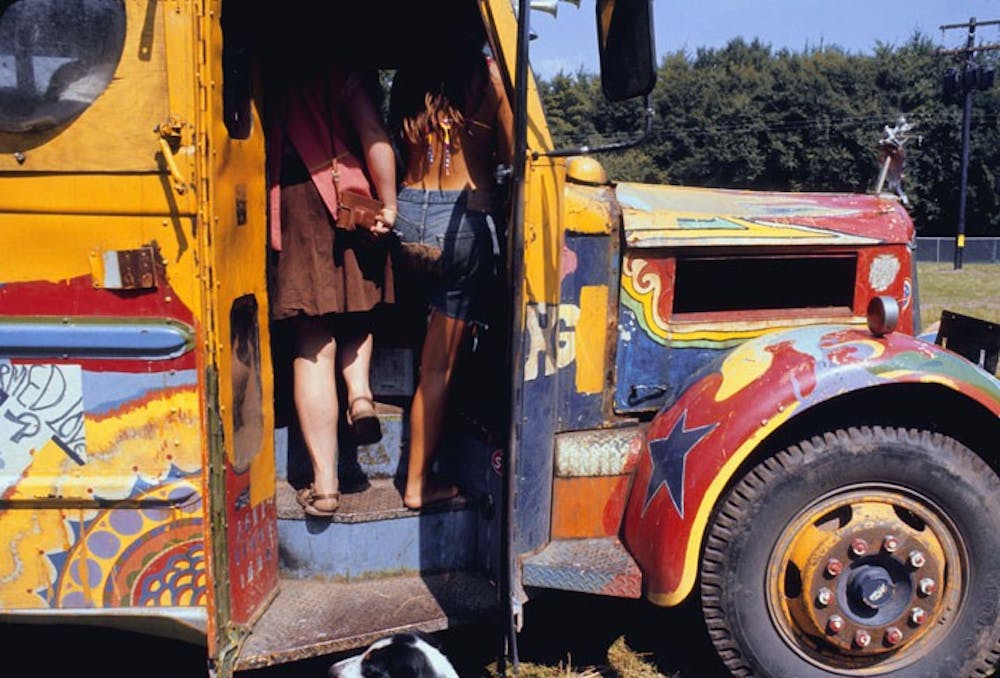It seems as though the summer of 2009 is attempting to recreate the inimitable summer of 1969 — the summer of peace and love. The counterculture is making a comeback, having been re-imagined in films like Ang Lee’s “Taking Woodstock” as well as in fashion and literature. Now it seems like D.C. is finally catching on.
The Newseum has opened a new exhibit on the Woodstock Music and Art Festival of 1969, titled “Woodstock at 40: The Rise of Music Journalism.” It takes a deeper look at the journalistic aspect of the famed music festival, doing more than just posting images of happy hippies in a muddy farmland. There are never-before-seen photos and film footage alongside letters and original promotional pictures.
The exhibit is easy to find, located on the Newseum’s fourth floor with wild psychedelic print covering the entrance. Along the walls are boards laden with photos, magazines and newspapers that covered Woodstock at the time. The first board tells of Mark Goff, a journalist that attended the festival when he was 22, writing for underground newspaper “Kaleidoscope.” He was particularly fascinated with Janis Joplin and took many fantastic and haunting photographs of the late singer. He also shot pictures of Sly Stone and Ravi Shankar.
On another board is the original list of performers and their salaries. If you must know, Jimi Hendrix and Janis Joplin topped the bill, each collecting $15,000. Salaries also went as low as $2,000; the Grateful Dead, a band synonymous with counterculture movement, was paid a meager $6,750.
Despite the low budget for the festival, concertgoers and promoters soon realized that it was not about the money. It was all about keeping the peace, love and drugs flowing. Photographer Henry Diltz, age 30 at the time, captured some of the more personal moments for “Life” magazine. He photographed the 400,000-person crowd, as well as many of the happy, naked concertgoers. Diltz also captured young Woodstock producer Henry Lang and Hugh Romney, also known as Wavy Gravy, who donated tons of food from the Hog’s Farm Collective. Also depicted were members of Jefferson Airplane and folk crooner John Sebastian. In between Diltz’s photographs are other pictures of the crowd and the farm before the festival took place. In addition, original front page covers of “Rolling Stone” and “New York Sunday News” are on display.
Perhaps one of the more interesting series of photographs in the exhibit is the one that focuses on Dan Garson. Garson was a 17-year-old photographer covering the festival for his school newspaper, and in the process, captured incredible photos of the festival. Many of these photos have never been seen before, as Garson passed away in the ‘90s, leaving the photos behind in his home basement. However, a friend of his was able to recover the photographs and letters written by Garson. The photos include Jimi Hendrix jamming out onstage, Joan Baez singing in the moonlight, and Joe Cocker belting out his signature blues remake of the Beatles classic, “With a Little Help From My Friends.” There are photos of hippies lying out on blankets, festival-goers riding motorcycles and teenagers bathing in the lake. Also recovered were letters written by a young Garson talking about the miles of traffic, the food shortage, the surplus of drugs, spaced-out teens everywhere and the kindness he observed from everyone.
Garson’s personal account of the historical event is incredible, transporting the observer, taking him back to a unique event. His section leads to the last part of the exhibit: a short film about the original Woodstock documentary by Michael Wadleigh, along with footage and commentary from people who were there. Psychedelic rock music is heard in the background, while images of dancing hippies and musicians in the mud and grass are shown. There are soundbites from the likes of Richie Havens and David Crosby, both performers at the event. It is a short burst of psychedelia, leaving the images of a crowd of 400,000 people huddling around a stage ingrained in memory.
The exhibit in itself is short, but packs together many memorable and inspiring images. The photos of legendary performers and the lucky hordes of people who attended are each iconic in their own way. Even if you do not care about the counterculture, it is still a wonderful exhibit to learn about music journalism. If you didn’t know much about Woodstock before, you will come out of this exhibit wishing you had been there.
You can reach this writer at thescene@theeagleonline.com.





